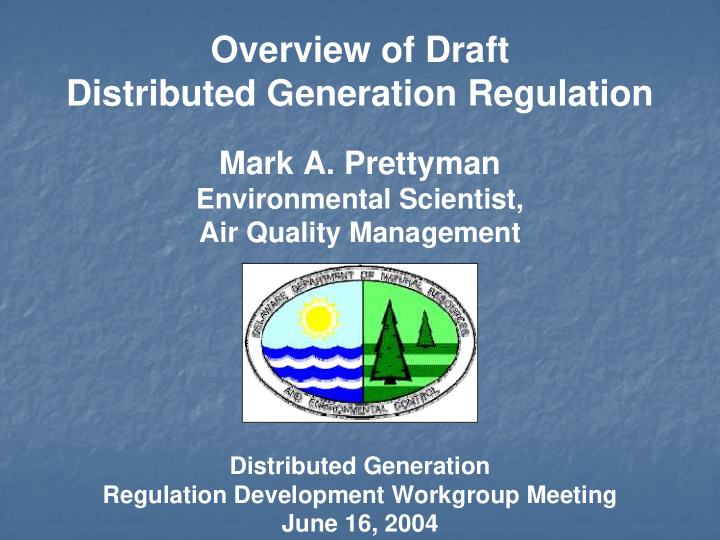



Overview of Draft Distributed Generation Regulation Mark A. Prettyman Environmental Scientist, Air Quality Management Distributed Generation Regulation Development Workgroup Meeting June 16, 2004
Distributed Generation Regulation The purpose of the regulation is to ensure that emissions from generators in the State of Delaware do not adversely impact public health, safety, and welfare, to include causing or contributing to a violation of the health based ozone or particulate matter National Ambient Air Quality Standards.
Applicability •Regulation No. 44 (Draft 1) only applies to stationary generators powered by internal combustion engines, except for combustion turbines. •The requirements of Regulation No. 44 (Draft 1) apply to both new and existing units. •Existing units are required to be in compliance 6 months after the effective date of the regulation.
Definitions “ Emergency ” means: •an electric power outage due to a failure of the electrical grid, on-site disaster, local equipment failure, or public service emergencies such as flood, fire, or natural disaster. •Possibility of including a provision to allow an “emergency event,” called by PJM, to be considered an “emergency,” as well. •Doing so would allow emergency generators, participating in PJM’s Emergency Response Program, to operate during “emergencies.” •Department would have to concur with the declaration of the “emergency event” before such emergency generators would be allowed to operate.
Definitions “ Emergency generator ” means •a generator used only during an emergency, during testing, or for maintenance purposes •it must not be operated in conjunction with a voluntary demand-reduction program or any other interruptible power supply arrangement with a utility, other market participant, or system operator (e.g., Conectiv, Delaware Electric Cooperative, PJM, etc.), except for PJM’s Emergency Load Response Program “ Non-emergency generator ” means •a generator that is not an emergency generator
Definitions “ New ” means a generator which: •is installed on or after [insert effective date], •is reconstructed on or after [insert effective date], or •began operating in conjunction with a voluntary demand- reduction program or any other interruptible power supply arrangement with a utility, other market participant, or system operator (e.g., Conectiv, Delaware Electric Cooperative, PJM, etc.) on or after September 21, 2003. “ Existing ” means” •a generator which is not new.
Definitions “ Stationary ” means an internal combustion engine: •which is not self propelled; •which is not intended to be moving while functioning; •which is intended to be used in a fixed application; or •which is used in a portable application and stays on a single property for more than 12 consecutive months.
Emissions Requirements Emergency Generators: •Existing: no emissions requirements. •New: must meet the emissions requirements of the EPA’s Nonroad standards at the time of installation. •40 CFR Part 89: compression ignition engines •40 CFR Part 90: spark ignition engines ≤ 19 kW •40 CFR Part 1048: spark ignition engines > 19 kW
Emissions Requirements Existing Non-Emergency Generators: •Existing units shall meet the following emission standards: Emission Standard Pollutant In lbs/MWh Nitrogen Oxides: 4.0 Nonmethane Hydrocarbons 1.9 Particulate Matter 0.7 Carbon Monoxide 10 Carbon Dioxide: 1,900
Emissions Requirements Existing Non-Emergency Generators: •As an alternative to the owner, an existing non-emergency generator which meets all of the following requirements shall be exempt from the emission standards: •The generator is equipped with a Rentar Fuel Catalyst, or an alternative emission control strategy approved by the Department; •It combusts a gaseous fuel, or a biodiesel blend; •It participated in Delaware Electric Cooperative’s Interruptible Service Program prior to September 21, 2003 and continues to participate to the current day; and •It has a standby power rating equal to or less than 450 kW.
Emissions Requirements New Non-Emergency Generators: •New units shall meet the following emission standards: Emission Standards in lbs/MWh Installed on or Installed on or After [Effective Date] After January 1, 2008 Pollutant Nitrogen Oxides: 0.6 0.3 Nonmethane Hydrocarbons 0.3 0.15 Particulate Matter 0.7 0.07 Carbon Monoxide 10 2 Carbon Dioxide: 1,900 1,900
Operating Requirements •Operation of any generator for maintenance or testing shall be limited to 50 hours during any 12 consecutive months. •There are no limits on the amount of hours any generator may run during an emergency. •No generator may be used for testing on an “Ozone Action Day.”
Fuel Requirements •Diesel fuel or a biodiesel blend, combusted in a generator, shall have a sulfur content equal to or less than: •0.05% by weight, before July 15, 2006; and •0.0015% by weight, on and after July 15, 2006. •A biodiesel blend combusted in a generator shall be a biodiesel blend of B5 or greater. •Gaseous fuels combusted in a generator shall contain no more than ten grains total sulfur per 100 dry standard cubic feet.
Record-Keeping and Reporting Requirements •The owner of a generator must keep all records pertaining to a generator for a minimum of five years. •Records can be kept on-site, or at another approved site. •Original records, or copies of records shall be submitted to the Department upon request.
Record-Keeping and Reporting Requirements •The following records must be recorded by the owner: •Monthly and annual amounts of fuel consumed by a non-emergency generator; •Monthly and annual operating hours for a generator; •The date, duration, and type of fuel used during operation; and •A shipping receipt and certification for each shipment of liquid fuel received.
Miscellaneous Requirements •A non-resettable fuel metering device shall be used if: •a non-emergency generator shares a fuel tank with other engines, or •a non-emergency generator is supplied fuel from multiple fuel tanks. •Neither certification nor compliance with this regulation relieves owners from compliance with all other applicable state and federal regulations.
Issues to Resolve •Certification by owner and/or suppliers (see draft of section) •Credit for concurrent emissions reductions (see draft of section) •Permitting requirements
Recommend
More recommend